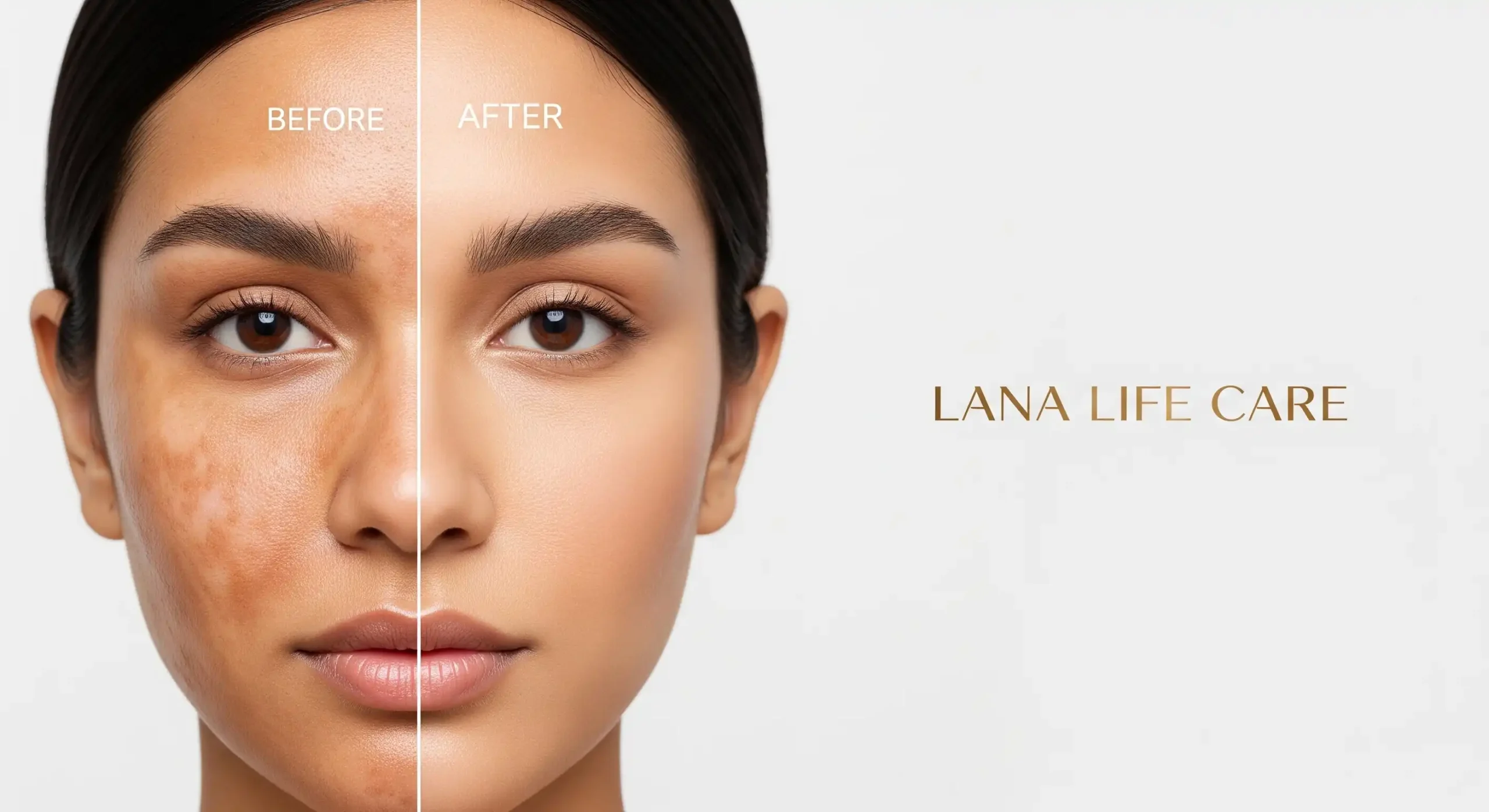
Melasma is one of the most bothersome skin conditions for many women and girls, as it significantly impacts their overall appearance, particularly when its prevalence is high on the skin. Therefore, dermatologists and beauty experts seek to use the latest treatment techniques to get rid of this problem, such as the Best Treatment for Melasma on Face
The most prominent scientifically and medically supported and best treatment for melasma on face is:
Using the best skin care for melasma, such as creams containing hydroquinone, retinoids, and kojic acid, is considered the best cream for melasma.
Medium to deep chemical peels are among the most effective and best treatment for melasma on face as they accelerate skin cell renewal and effectively remove pigmentation.
Advanced technologies such as fractional laser or Intense Pulsed Light (IPL) are also effective methods for removing melasma and reducing melanin oxidation.
Combining any of the above melasma treatment methods with other treatment techniques, such as hydration IV therapy or vitamin shots, through the services of IV drip at home in Dubai under full medical supervision, provides comprehensive treatment for skin, pigmentation, melasma, and immunity.
Melasma is an irregular, dark pigmentation that appears on the skin, often on the face, as a result of increased melanin production. It is characterized by brown or gray hues and is often associated with pregnancy, hormonal changes, or sun exposure. It may appear on the forehead, cheeks, and upper lip. Treatment always includes sun protection and anti-pigmentation techniques.
Also read: Fat Dissolving Injections in Dubai
Before determining the best treatment for melasma on face, it’s important to understand the causes and factors that influence its appearance, which include:
Hormonal changes, such as those that occur during pregnancy or as a result of taking birth control pills, are a major factor in stimulating melanin production in the skin, leading to the appearance of dark spots known as melasma, especially on the face. Therefore, melasma is more common in pregnant women or women using hormones.
Sunlight stimulates the skin’s pigment cells to produce more melanin, which worsens melasma.
For this reason, prolonged exposure to direct sunlight is one of the most significant factors that contribute to the appearance of melasma, especially when not using an effective sunscreen with a high SPF.
Play a significant role in the development of melasma, as family history has a clear impact on the likelihood of developing melasma.
If a family member has melasma, your chances of developing it increase, especially since this genetic link may make the skin more sensitive to factors such as the sun or hormonal changes, leading to the development of pigmentation more easily.
Taking medications such as anticonvulsants or lithium may stimulate the cells responsible for producing melanin in the skin, contributing to the appearance of melasma spots.
In particular, these medications affect the body’s chemical balance and may increase the skin’s sensitivity to sunlight or hormonal changes. Therefore, it is important to consult a doctor if you notice any pigmentation during treatment.
The types of melasma vary according to the depth of pigmentation and its concentration in the skin layers, as follows:
The epidermal melasma is the most noticeable and easily treated type. It is characterized by pigmentation in the upper layer of the skin, appearing as well-defined brown patches.
It often responds well to topical creams and superficial peels, and shows significant improvement within a short time with the use of sunscreen and regular treatment.
Deep melasma is characterized by pigmentation penetrating deep into the skin’s layers and appearing gray or dark blue, making it more difficult to treat.
This type does not respond easily to traditional treatments and often requires specialized laser sessions or techniques such as mesotherapy to achieve tangible results, with patience and consistent treatment.
This type combines the characteristics of superficial and deep melasma, appearing in varying shades of brown and gray. It is the most common type among women and may require a combination of topical and technical treatments to achieve satisfactory results.
Mixed Melasma requires a thorough diagnosis by a specialist to determine a comprehensive treatment plan that suits the skin condition and type of melasma.
Also read: Glutathione injection price in Dubai
Melasma symptoms appear gradually and are often aesthetically disturbing, especially on the face. The most important symptoms that dermatologists rely on to diagnose the condition are:
Melasma is often diagnosed visually by a dermatologist using a Wood’s lamp, and sometimes a skin test may be ordered to confirm the type of pigmentation.
Best treatment for melasma on face depends on its severity, type, and skin response. Dermatologists develop a comprehensive treatment plan that aims to reduce pigmentation and improve skin tone using safe medical methods.
Include melasma removal cream containing hydroquinone, tretinoin, or kojic acid, used to lighten dark spots and gradually reduce pigmentation with regular use and under medical supervision.
considered among the best treatment for melasma on face that use mild acids, such as glycolic or salicylic, to remove the surface layers of the skin, helping to rejuvenate the skin and effectively reduce the appearance of melasma over time.
Laser therapy is used to break down melanin pigment in areas affected by melasma. It is usually used for people who have not responded to traditional treatments. However, it requires extreme caution to avoid skin irritation.
This technique helps stimulate collagen production and improve the absorption of topical creams, enhancing the effectiveness of the treatment and contributing to a gradual reduction in melasma, especially when combined with medical serums.
Sometimes, the doctor, besides the best treatment for melasma on face, may recommend some methods of treating the skin from within that would enhance and strengthen the health of the skin and support the effect of treating melasma, such as resorting to Glutathione IV drip.
Also read: What to avoid when taking glutathione IV?
To quickly address melasma, doctors recommend a set of effective solutions that deliver tangible results in a short time, provided you strictly adhere to instructions and avoid the causes of pigmentation, such as:
Continued use of the best face cream for melasma, such as those containing ingredients like hydroquinone, niacinamide, or azelaic acid, works to lighten dark spots quickly, along with skin boosters.
Sun exposure directly triggers melasma, so using a sunscreen with an SPF of 50+ is essential to reduce pigmentation. It’s best to reapply it every two hours, especially when going out during the day.
Drinking adequate amounts of water, taking antioxidants, and getting good sleep promote skin recovery and significantly reduce the severity of pigmentation in a short period.
It is also essential to adhere to the treatment plan, the type of melasma treatment prescribed by the doctor, and the number of treatment sessions to minimize melasma pigmentation as much as possible.
Topical products are the first line of treatment for melasma, especially if they are well-studied and clinically proven. Choosing the right and best products for melasma helps lighten dark spots, even out skin tone, and prevent recurrence of pigmentation. Some of the best of these creams include:
NIVEA Luminous630 Anti Dark Spot Serum
This product from NIVEA is a unique innovation for treating pigmentation. It contains the Luminous630 complex, which gradually reduces dark spots and gives the skin an even radiance, and it is also suitable for sensitive skin and has been approved by dermatologists.
It is considered one of the best creams available medically for treating melasma. It contains tranexamic acid, niacinamide, and kojic acid, a powerful formula that reduces pigmentation without causing skin irritation, and it is suitable for daily use.
This cream is one of the best treatments for melasma on the face and is suitable for medium to dark skin. It contains an effective combination of hydroquinone and vitamin E to help reduce dark spots and even out skin tone while deeply hydrating.
A great topical treatment for those with mild to moderate melasma. It contains gentle retinol that works to regenerate skin cells and gradually reduce pigmentation without causing dryness or sensitivity, thanks to the presence of ceramides.
Also read: Glutathione Injection for Skin Whitening
Chemical peels are an effective treatment option for melasma, especially superficial types, by using acids such as glycolic or salicylic acid to exfoliate the upper layer of skin, gradually lightening the pigmentation.
However, they must be performed under close medical supervision to avoid irritation or worsening. It is also recommended to apply a strong sunscreen after treatment to ensure results and stabilize skin tone.
Regarding the effectiveness of laser treatment, it is used to treat melasma cases that are resistant to topical treatments, especially low-energy lasers such as Q-switched Nd: YAG. It helps break down melanin and improve skin tone, and its results vary from person to person.
However, Laser therapy can cause irritation or recurrence of pigmentation if not used carefully. This highlights the importance of consulting a specialist dermatologist to accurately assess the condition and determine the most appropriate treatment protocol.
To prevent melasma from returning after treatment, you must follow a consistent skincare routine and avoid the underlying triggers. Here are the most important daily tips for prevention and maintaining treatment results:
Also read: Immune Booster IV Drip
No one-size-fits-all solution for treating melasma; So, at Lana Life Care, we offer a customized treatment plan tailored to your skin type, melasma severity, and lifestyle.
Consult with our board-certified dermatologists for a thorough assessment and treatment that combines effective creams, advanced techniques such as lasers and peels, and regular follow-up services.
Book your consultation with us today – and ensure brighter, clearer skin, free of annoying pigmentation.
Laser therapy or chemical peels with specialized creams provide the fastest results, especially under medical supervision.
The best treatment for melasma on the face is a combination of lightening creams, laser or peeling sessions, and sun protection.
According to experts, fractional laser, mesotherapy, and glycolic peeling are among the best facials for melasma.
There may be no definitive cure; however, it can be controlled for the long term with regular treatment and daily prevention.



